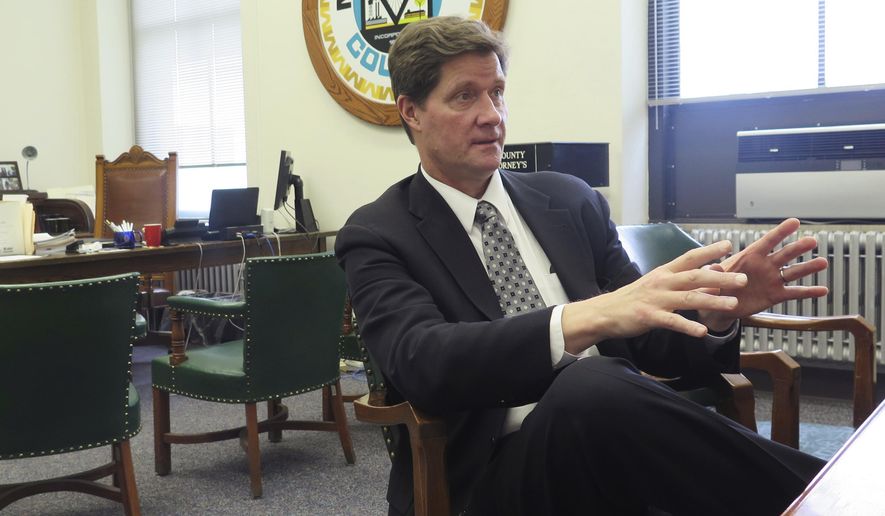MILWAUKEE (AP) - For Jeremy Arn, being a prosecutor in Milwaukee’s most dangerous neighborhoods means spending more time on the streets than in court.
His officemates are police officers in District 5, the city’s busiest, and his focus is not just locking people up, but preventing crime and giving people second chances.
The transformation of the prosecutor’s traditional role and the collaboration with police has special significance in Milwaukee, where the incarceration rate for African-Americans in some neighborhoods is the highest in the U.S. and law enforcement is hoping to rebuild a strained relationship after two nights of riots last summer when a black officer fatally shot a black man during a traffic stop. The arrangement has made prosecutors more accessible to residents, though its success is much harder to quantify than courtroom work.
On one recent afternoon, Arn, who previously worked as a contractor for the State Department teaching prosecutors in Afghanistan and as a rule of law adviser in Iraq, cheered the sight of an empty street, much like he would a conviction - because it meant criminals were gone, at least for now.
“Look at that. It’s a ghost town; that’s awesome,” he said as he rode with a police officer past a convenience store that’s been the site of loitering and drug-dealing complaints but had recently followed advice from police and Arn to hire armed security.
While on patrol, Arn, 39, trades his courtroom attire for cargo pants, a plaid shirt and the required bulletproof vest. When he invites a landlord to the police station to talk about a property that might be the site of prostitution and drug trafficking, Arn tells her she’s not in trouble before making suggestions on how deal with the problem.
The model of putting prosecutors in neighborhoods began in Portland, Oregon, in 1990, when a business district helped fund the effort. Variations of the concept have spread around the country, but Milwaukee is one of just a few places to put prosecutors in police stations.
The idea is more relevant than ever as police nationwide try rebuild the public’s trust after high-profile shootings. The Prosecutors’ Center for Excellence, an organization of district attorneys, last year singled out combined police/prosecutor presence in communities as “essential to combat this mistrust in law enforcement.”
“The ground has shifted, and people are now conscious and aware of the systemic issues to a degree that they are actually demanding that we solve problems and not simply take the politically convenient route of the tough-on-crime rhetoric,” said Milwaukee County District Attorney John Chisholm, whose office is relying on federal grant money to put a prosecutor in each police district in Milwaukee.
But that funding is not guaranteed. If funding is not renewed by the U.S. Justice Department by July 22, the district attorney’s office will pull prosecutors from three of the city’s seven police districts, including the one where riots erupted last year.
Most of Wisconsin’s black residents live in Milwaukee’s north side neighborhoods covered by District 5 and District 7 - where more than half of the city’s homicides last year occurred. A study from the University of Wisconsin-Milwaukee found that almost all of the black men behind bars in the state during the 2010 census were from Milwaukee north side neighborhoods. In one particular ZIP code, 53206, nearly half the residents live below poverty level, 13 percent are unemployed, and a quarter of the housing units are vacant, according to 2015 census estimates.
“If you keep intervening through arrest and formal prosecution, you’re just going to continue to disenfranchise that same pocket of neighborhoods and of people,” said Jeffrey Altenburg, a deputy district attorney who helped launch the initiative in Milwaukee about a decade ago.
As part of their efforts, Milwaukee prosecutors are looking for alternatives to prison for nonviolent offenders. About 70 percent of the nearly 900 people who took part in deferred prosecution agreements in the last two years have fulfilled conditions that can include completing drug treatment, staying out of legal trouble, or taking job training classes.
“You have a big say about what can happen to somebody’s life, and it’s important to take that seriously,” said Hanna Kolberg, the prosecutor stationed in District 7, the site of the riots.
A key aspect of the initiative is to focus on people and places that have a disproportionate impact on an area, whether it’s habitual offenders or businesses and vacant homes that become a magnet for criminal activity. That’s why much of the work is driven by what prosecutors and police hear from residents at neighborhood meetings, where they learn about drug dealers, nuisance properties and other concerns.
Assistant Police Chief James Harpole, an early skeptic of the program when he was a district commander, now he thinks of the effort as part of a “holistic approach” to improving the community. Plus, he said, “It has helped to break down barriers, to make the community and police closer.”
At a recent meeting between residents and officers of District 5, Josephine Key told a police captain that she would like to see more officers patrolling on foot.
“I would love to see my son get along with you guys,” Key, 64, said.
Police and prosecutors still have detractors. Milwaukee’s American Civil Liberties Union is suing the Police Department alleging officers have targeted minorities for stops - a charge the department denies. And Chisholm has been criticized for not prosecuting a white officer who fatally shot a mentally ill black man in 2014.
Arn said residents’ mistrust of police runs deep, but he’s determined to overcome it.
“Every appearance we make outside of the traditional squad car, every meeting we show up at, even if we’re getting yelled at, it’s a chance to build that relationship,” Arn said.




Please read our comment policy before commenting.